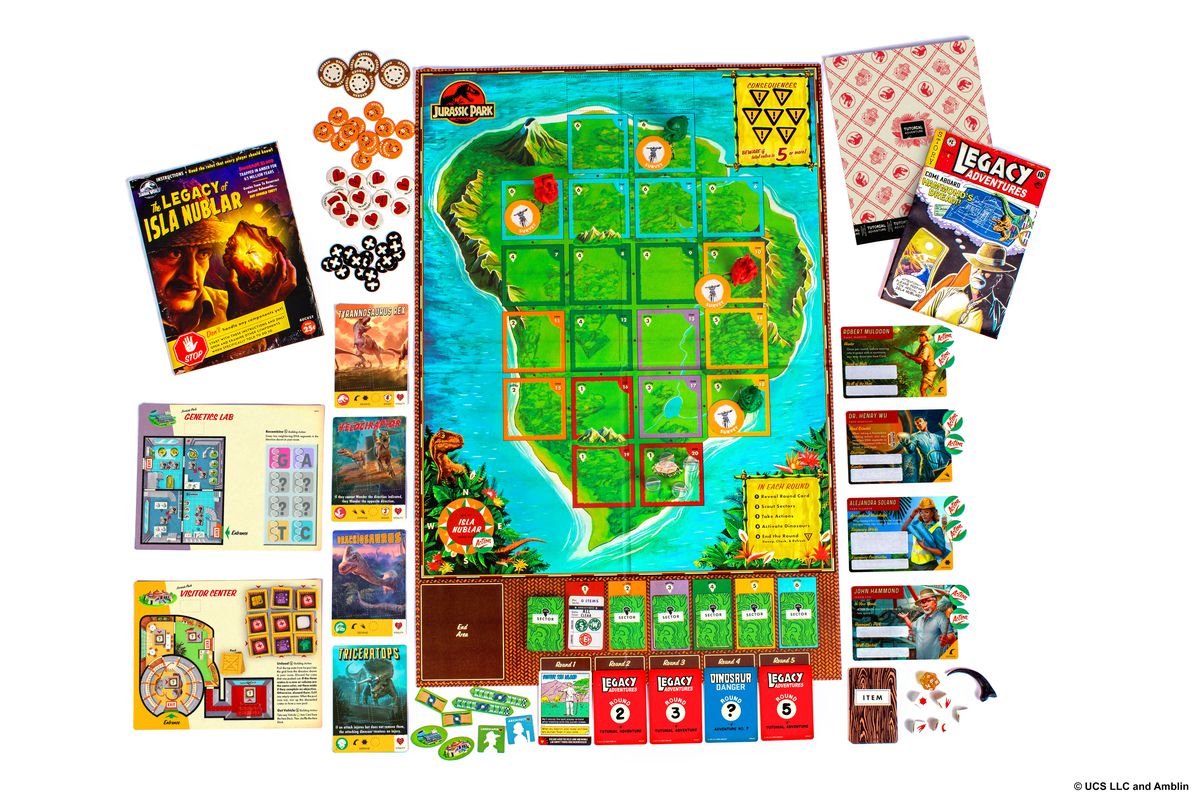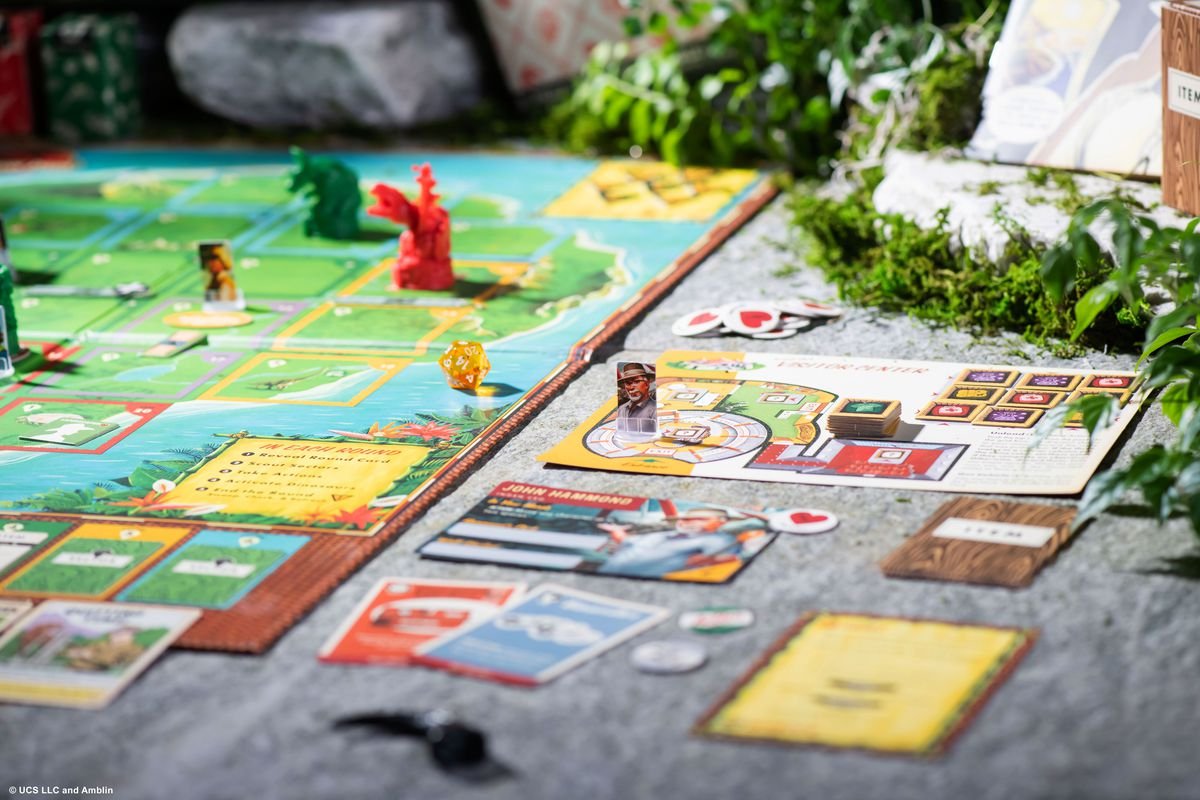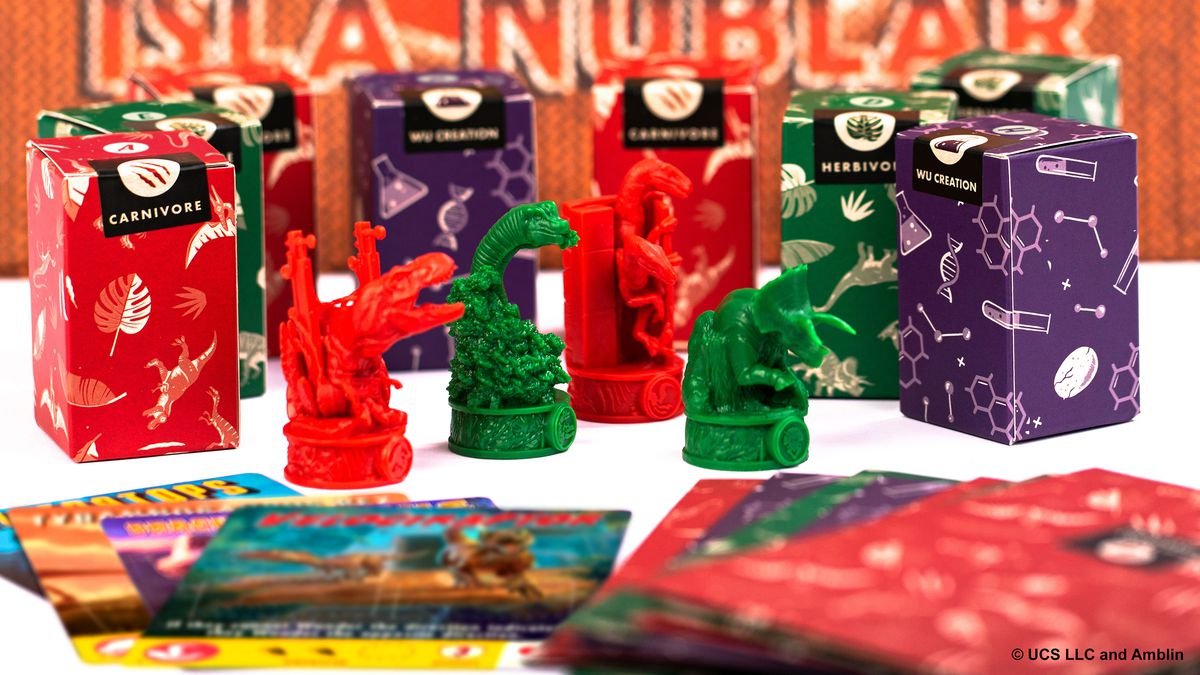Jurassic World: The Legacy of Isla Nublar is the latest legacy-style board game, a genre which allows players to permanently modify components with stickers, explore new content in every game, and tear up cards. Popularized by titles such as Pandemic Legacy and Gloomhaven, it evokes a delicious sense of emotional investment, adding depth and permanence to player decisions that give texture to an extended campaign. In this case, committing to the full 12 scenarios of Isla Nublar is worth the effort — as long as you’re only playing with a single partner or two.
This large box has something that its predecessors do not, and that’s the beaming Jurassic intellectual property. The film franchise has remained relevant in pop culture ever since the debut of the wondrous 1993 film. Its charisma is evident across every inch of this product. The visual motif apes ’90s comic books, giving the complete package lots of personality. This is striking on the board itself as well as in the large number of cards found in the game, but it’s most pronounced in the little booklets found in each of the scenario envelopes. Every chapter of the game comes with its own small comic describing the new components, listing additional rules, and offering an illustrated narrative snippet to set the tone. It’s a loving touch — despite the oddity of channeling the movie’s era as opposed to frames from the actual films.

Photo: Prospero Hall
The Legacy of Isla Nublar begins with the series’ origins in Jurassic Park. Each scenario progressively reveals subsequent films in the franchise, spotlighting favorite characters and even intertwining iconic moments. The first scenario — effectively a dream sequence inside the mind of Dr. Hammond as he commutes to the island — is the most bland and lacks an overt hook. It serves as a tutorial, gently introducing players to the core ruleset and the functions of the park’s inhabitants. In this respect it certainly works, but it can leave a very soft and ineffectual first impression.
The implementation of the classic legacy structure reminds me most of Pandemic Legacy. You open new content for each scenario, and progress through an evolving overarching narrative from game to game. New rules are regularly introduced and layered cleverly upon the streamlined core structure. What works rather wonderfully here is the evolution of the park itself. This is the game’s big hook, and what it pulls off most superbly.
You will create infrastructure, place buildings, fence in attractions, and commit to sticking things on the board that you later regret. At first it all begins somewhat meekly, placing a new dinosaur here, a new building there. But everything seems to cascade as the budget grows over time, a function of the increased challenge of maintaining order with a burgeoning set of carnivorous inhabitants.
[Ed. note: This review contains light spoilers for Jurassic World: The Legacy of Isla Nublar.]

Photo: Prospero Hall
The structure of play largely remains the same over all 12 games of the campaign, although the action and consequences are elevated. Players take on the role of a known Jurassic personality, such as Dr. Sattler, Owen Grady, or even Dennis Nedry, cooperating together to spend their action points efficiently in order to complete objectives. Tasks include herding rampaging dinos, pursuing story beats such as locating missing civilians or offering guided tours, and participating in a set of minigames that vacillate between amusing puzzle and monotonous drudgery. You’ll rummage around in the visitor center, literally shifting boxes around in a match-three game. You’ll sequence genomes in the lab, moving CTAG-coded tiles around in a tile-laying puzzle. Later, you will even need to bring the power back on in a “hold on to your butts” push-your-luck activity.
The overall scenario structure is iterative, repeating over and over again in the campaign with variance primarily occurring in the story-focused objectives that mimic the franchise’s various film plots. It again homes in on nostalgia and appeals to emotion. The creativity allotted in park development sits in sharp contrast to the rigid, almost on-rails nature of the campaign’s narrative. Building the park itself to suit your play style is absolutely the most sophisticated portion of the game, allowing for a surprising amount of freedom that endures over the entire campaign.
This decision to blend a duality of economic park management with a more micro scenario-based adventure game is nearly the perfect format for this franchise. Funko Games’ Prospero Hall imprint executes it surprisingly well. The campaign allows for the overarching legacy decisions to create minute impacts that reverberate through the comic book adventures. The two formats feed into each other, performance in the narrative adventures affecting subsequent budget allotment. It’s a strong ecosystem that is gratifying to see play out.
The campaign arc is similarly strong. The park construction aspect peaks prior to the final act, which consists of an iconic situation from late in the film franchise. This allows players to reap the benefits of their creation — Isla Nublar itself. The magical sense emanating at the climax of a well-designed engine-building tabletop game is found in the managerial portion of play, and you actually get to live in and utilize that construction before the box closes for good.

Photo: Prospero Hall
It’s a boon that Jurassic World: The Legacy of Isla Nublar nails the broad strokes vital to this style of game, because it does occasionally get lost in the details. For all the interesting narrative quips in the scenario booklets, the design gets bogged down at times, forcing busywork on the players. The aforementioned minigames often feel more like a chore than exciting. The creative spark around this activity fades over time, and I began to dread heading back to the visitor center and rifling through more tchotchkes so Hammond could hawk some merch.
These mechanical subsystems are clever the first time you figure them out, maybe even the second. But by the fifth scenario they’re a nuisance, detracting from the more enjoyable elements, like herding dinosaurs and searching for lost children. This failing can be smoothed over somewhat by rotating which player at the table will be assigned the dirty work each session, but that’s a Band-Aid at best.
Awkwardly, this problem is more severe with a higher player count. This is because the parkgoers are given a set of nine action tokens regardless of the number of participants sitting at the table. So with three players, you each get a generous three actions per round. When playing with four, you are only guaranteed to get two. At this maximum number of players, each individual’s active participation is relatively minuscule — with more players there is literally less for each individual to do. With only two actions a round, a single player will need to spend nearly half the game just shuffling crates or DNA tokens. Unless you can squeeze joy from the table-talk and overall strategic decision making, those tasked with janitorial duty might not want to show up for next week’s game. The action scaling is frankly a huge blunder and leaves The Legacy of Isla Nublar working best at only two or three players.
Overall, however, it’s hard to overlook the game’s cost. This is a big box with a solid amount of content, but at a colossal ask of $120 it’s fighting a desperate battle for disposable income. Prices have been rising in recent years, but such a high bar simply puts it out of reach for those hovering on the edge and not entirely sure if they want to commit.
Even with these shortcomings, the legacy elements alone may carry some groups through the experience and justify the expenditure. Characters will grow over time as you scratch off new abilities. Those options from previous films may reappear in a cameo of sorts, offering a new suite of helpful powers found on the back of their character cards. Events occasionally offer multiple options to scratch off. New dinosaurs are unlocked and evolve over the course of the campaign. There is a constant stream of new content, almost too much of it. Some scenarios will require 10 minutes of setup and rules-reading, and then may result in a loss only 20 minutes later. Thankfully, this is somewhat uncommon even if it is a real possibility.

Photo: Prospero Hall
This can be a very difficult game. Often, it’s the result of random events not going your way, such as objectives taking longer than expected to fulfill or dinosaur activations simply wrecking you unavoidably. Fortunately, the fail-forward philosophy means that even your worst performances allow you to progress and improve the park. I found this to actually be satisfying as I’d rather a game not pull punches and instead present an evolving challenge. Regardless of your success, you will always find neat new things to open and cards to be scratched off. It’s exhilarating, and there are a couple of moments, particularly those that delve into the genetic research and allow you to tinker with science, that actually meet substantial expectations.
Jurassic World: The Legacy of Isla Nublar is an evocative legacy-style board game that harnesses the format astutely. There are areas of the design that stumble, perhaps drastically at times, but if experienced properly with suitable expectations, the journey will prove novel and ultimately satisfying. It’s quite the accomplishment that the mystery and surprises experienced still present as fresh despite the range of legacy games now available. Furthermore, they don’t simply feel unique, but they truly feel like the original Jurassic Park — capturing a feeling and emotion that’s been diminished in the most recent set of films.
You can find Jurassic World: The Legacy of Isla Nublar at your friendly local game store.
Jurassic World: The Legacy of Isla Nublar was reviewed using a retail copy provided by Funko Games. Vox Media has affiliate partnerships. These do not influence editorial content, though Vox Media may earn commissions for products purchased via affiliate links. You can find additional information about Polygon’s ethics policy here.
























































